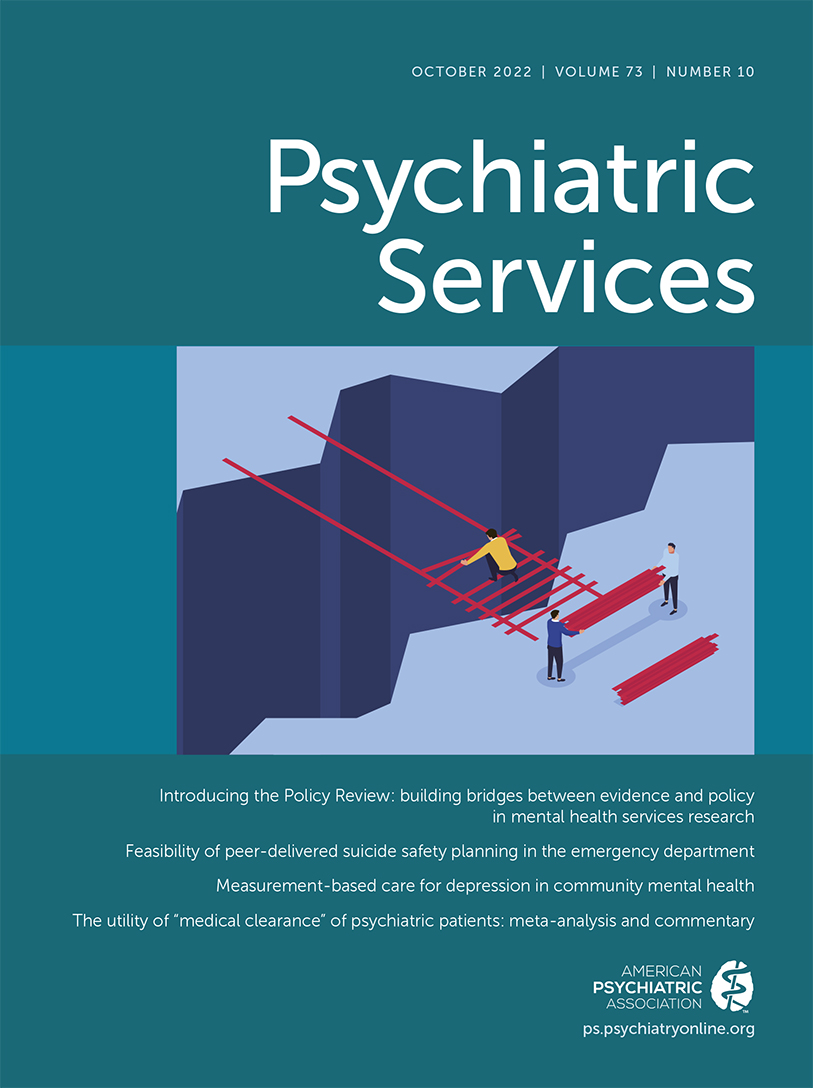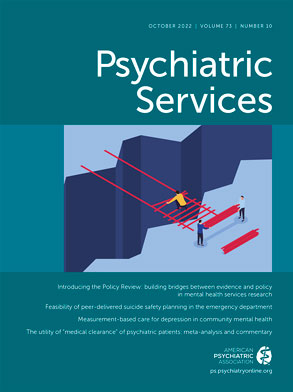Enthusiasm for digital interventions to serve as an inexpensive, scalable treatment option among people with eating disorder symptoms continues to grow (
1). However, despite the promise of these options, continued issues with uptake (accessing a digital program) and compliance (continued use of the digital program) have been observed, limiting the full potential of digital interventions in this population (
2).
One reason for low-usage patterns has been the low level of acceptance of digital interventions reported in this population. Barriers to acceptance include limited trust in their effectiveness, concerns with data security, technology anxiety, and preference for face-to-face treatment (
3). Acceptance-facilitating interventions (AFIs)―educational videos that aim to provide trustworthy information about digital interventions, address common concerns and misconceptions, and motivate individuals to engage in this form of treatment―have proven effective in addressing these barriers in certain clinical populations (
4,
5). However, acceptance and usage are distinct concepts; thus, it is unclear whether increased acceptance from an AFI also translates to greater usage. For example, low acceptance reflects a negative appraisal of, and little intention to use, a digital platform, whereas low usage could reflect initially high acceptance but discontinued use over time for various reasons (loss of motivation, busy schedule, etc.).
In this study, we tested the impact of an AFI tailored to digital interventions for binge eating. We examined whether individuals exposed to the AFI reported greater acceptance of digital interventions and patterns of increase usage compared with those in a control group.
Methods
A detailed description of our methods is available as an
online supplement to this report. This study was preregistered (ACTRN12621001054808) but was also part of a large trial of digital interventions for binge eating. Participants were recruited in July–August 2021 via a psychoeducational online platform on eating disorders. Eligibility criteria were age >18 years; access to the Internet; and self-reported recurrent binge eating, defined as engaging in at least one episode of objective binge eating per fortnight, on average, in the past 3 months, which is below the diagnostic threshold of one binge eating episode per week. Ethics approval was obtained from the Deakin University Human Research Ethics Committee.
After completing baseline surveys that assessed for demographic and clinical characteristics, participants were randomly assigned to either the AFI (N=198) or control group (N=200). Participants assigned to the AFI were shown a brief informational video about digital interventions before completing measures to assess for primary and secondary outcomes. Participants in the control group completed the same outcome measures immediately. Participants were then given access to a digital intervention to use over 4 weeks (see Figure S1 in the
online supplement).
The AFI consisted of a 6-minute video that provided information about digital interventions for binge eating, with the aim of positively influencing participants’ acceptance and attitudes. Content was based on knowledge of barriers to acceptance of technology. Information was presented about how digital interventions can be defined, evidence for their effectiveness, and their wide-ranging benefits. Common concerns were also addressed. Internet anxiety was addressed by guiding participants through the login process of a digital intervention, demonstrating how to access content, and notifying them of the possibility of receiving technical support. Concerns with data privacy were addressed by informing participants about anonymous data processing and the use of an encrypted platform accessible only by the researchers. An example of a digital intervention was presented along with tips for effective use.
To ensure that randomization was successful, various participants’ baseline characteristics were assessed (see
online supplement). The primary outcome was digital intervention acceptance, defined as intent to use a technology, with intent being the most proximal determinant of actual technology use (
5). Secondary outcomes included performance expectancy, effort expectancy, social influence, facilitating conditions, Internet anxiety, security concerns, current motivation levels, treatment preferences, attitudes toward digital interventions, and intervention uptake and adherence. (See the
online supplement for details about how these outcomes were assessed and score ranges for all scales.)
Chi-square and independent samples t tests were performed to test for group differences on baseline variables and key outcomes. Standardized mean difference and phi coefficients were computed as effect size measures. To protect against type I errors, we computed Benjamini-Hochberg false discovery rate–adjusted p values for outcome variables (
6).
Results
Participants’ baseline characteristics are available in the
online supplement. The sample was symptomatic, with a mean±SD objective binge eating frequency of 16.77±14.33 episodes reported over the past 28 days. No group differences on any baseline variable were observed, indicating that randomization was successful.
Table 1 presents results from the main analyses. For the control group, acceptance levels were high overall, with only 2% (N=4) classified as low acceptance, 38% (N=76) classified as moderate acceptance, and 60% (N=120) classified as high acceptance (per criteria proposed) (
5). In the AFI group, 1% (N=1) were classified as low acceptance, 26% (N=52) as moderate acceptance, and 73% (N=145) as high acceptance. Acceptance scores were significantly higher in the AFI group (16.63±2.09) than in the control group (15.88±2.57) (d=0.32).
Regarding secondary outcomes, the AFI group reported significantly higher scores than those of the control group on effort expectancy, facilitating conditions, motivation levels, and the Attitudes Towards Online Psychological Interventions Questionnaire (APOI) anonymity benefits subscale. The experimental group also reported significantly lower scores compared with the control group on measures of concern about data security, APOI skepticism, and perception of risks. Other secondary outcomes (including usage patterns) were nonsignificant.
Discussion and Conclusions
Participants exposed to an AFI reported greater acceptance of digital interventions for binge eating than those assigned to an assessment-only control group. Group differences were also observed on several secondary outcomes: the AFI group showed higher scores on effort expectancy, facilitating conditions, motivation, and anonymity benefits and lower scores on concerns about data security and perception of risks. However, no group differences were observed on usage rates in terms of both digital health uptake and adherence. The findings suggest that an AFI may positively influence acceptance of digital interventions for eating disorders and address several common barriers associated with their use (e.g., security concerns, limited knowledge of their evidence base). However, an AFI does not appear to influence beliefs that a digital intervention could effectively help participants manage their own symptoms, nor did it affect usage patterns.
Effect sizes observed on levels of acceptance and its drivers were noticeably smaller than those found in prior AFI research (
4,
5). This discrepancy could be explained in two ways. First, unlike prior studies, our sample voluntarily enrolled in a digital intervention trial, indicating that these individuals were considerably more interested in, open to, and accepting of this form of intervention delivery. Indeed, 66% (N=265) of our sample reported high acceptance, compared with <20% reported in prior studies (
4,
5). Thus, limited variability on key outcomes may have attenuated effects and may explain why some key drivers of acceptance (performance expectancy, social influence) that have been successfully modified through previous AFIs failed to reach significance in this study. Second, the discrepancy may involve the demographic composition of the sample. Unlike prior samples from AFI studies (
4,
5), our sample had limited demographic diversity, consisting mostly of highly educated, younger women. Because these demographic variables have been shown to influence help seeking and adoption of technological innovations (
7,
8), it is possible that between-study differences in effect sizes can be attributed to sample characteristics.
We found no evidence that AFI participants had higher rates of technology usage. This finding is consistent with the results from one study on an AFI for chronic pain (
9). It is likely that the delivery of information at one time point is insufficient to determine later intervention usage. Repeated efforts to maintain high levels of participants’ motivation via the delivery of other technological features (e.g., conversational agents) at different stages of the digital intervention may enhance usage patterns. An alternative explanation could be the insufficient tailoring of our AFI to relevant characteristics, given the plausibility that not everyone responds to the same content. Reported barriers to treatment uptake have been shown to vary across demographic and symptom profiles (
10), indicating that our one-size-fits-all content may not be suitable for promoting usage of a digital intervention among certain individuals.
Study limitations must be considered. First, our sample consisted of participants who self-enrolled in a digital intervention trial, indicating that this group was already open to engaging in this intervention format. Thus, the present findings cannot be generalized to non–help-seeking samples. Second, the use of an assessment-only control group may have produced inflated effect size estimates. It would have been more desirable to implement a placebo control condition, such as by presenting an alternative video that did not aim to modify acceptance. Third, as with all AFI studies, we based our trial on a posttest-only design, instead of a pre-post test design, to avoid high risk of repeated measurement bias, given the brevity of the experimental manipulation. Therefore, we could not demonstrate whether the AFI led to increases in these outcomes or whether effects varied as a function of baseline acceptance levels. Research implementing baseline assessments and addressing these questions is needed.
In conclusion, although a brief AFI may influence acceptance and its drivers, we found no evidence that it can affect digital intervention usage patterns. The significant rates of nonuptake (N=63, 15%) and noncompliance (N=215, 55%) observed in this study―similar to what has been found in other self-guided digital intervention trials (
11)―indicate that other strategies to enhance user engagement are needed. Because this help-seeking sample was already receptive to digital interventions, future research is needed to understand what role an AFI might play in eating disorder treatments. An AFI might be better suited for therapists than patients, by educating therapists about how this intervention format can complement their proposed treatment plan. For example, an AFI could help therapists realize that digital health tools can be beneficial between client sessions, or for clients put on a waitlist, as a way to bolster skill acquisition and utilization and relieve symptoms.

